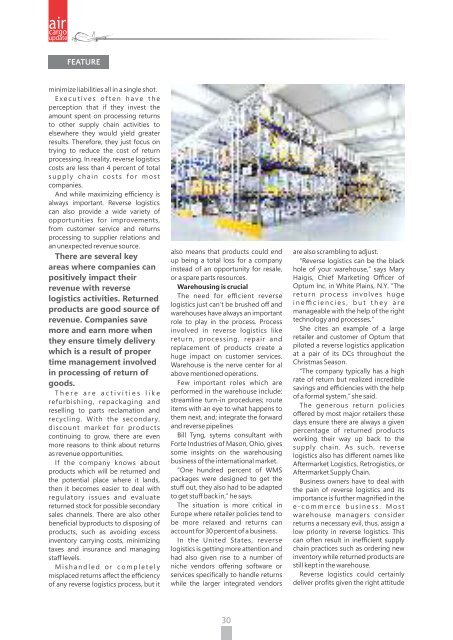ACU
Create successful ePaper yourself
Turn your PDF publications into a flip-book with our unique Google optimized e-Paper software.
FEATURE<br />
minimize liabilities all in a single shot.<br />
E x e c u t i v e s o f t e n h a v e t h e<br />
perception that if they invest the<br />
amount spent on processing returns<br />
to other supply chain activities to<br />
elsewhere they would yield greater<br />
results. Therefore, they just focus on<br />
trying to reduce the cost of return<br />
processing. In reality, reverse logistics<br />
costs are less than 4 percent of total<br />
s u p p l y c h a i n c o s t s f o r m o s t<br />
companies.<br />
And while maximizing efficiency is<br />
always important. Reverse logistics<br />
can also provide a wide variety of<br />
opportunities for improvements,<br />
from customer service and returns<br />
processing to supplier relations and<br />
an unexpected revenue source.<br />
There are several key<br />
areas where companies can<br />
positively impact their<br />
revenue with reverse<br />
logistics activities. Returned<br />
products are good source of<br />
revenue. Companies save<br />
more and earn more when<br />
they ensure timely delivery<br />
which is a result of proper<br />
time management involved<br />
in processing of return of<br />
goods.<br />
T h e r e a r e a c t i v i t i e s l i k e<br />
refurbishing, repackaging and<br />
reselling to parts reclamation and<br />
recycling. With the secondary,<br />
discount market for products<br />
continuing to grow, there are even<br />
more reasons to think about returns<br />
as revenue opportunities.<br />
If the company knows about<br />
products which will be returned and<br />
the potential place where it lands,<br />
then it becomes easier to deal with<br />
regulatory issues and evaluate<br />
returned stock for possible secondary<br />
sales channels. There are also other<br />
beneficial byproducts to disposing of<br />
products, such as avoiding excess<br />
inventory carrying costs, minimizing<br />
taxes and insurance and managing<br />
staff levels.<br />
M i s h a n d l e d o r c o m p l e t e l y<br />
misplaced returns affect the efficiency<br />
of any reverse logistics process, but it<br />
also means that products could end<br />
up being a total loss for a company<br />
instead of an opportunity for resale,<br />
or a spare parts resources.<br />
Warehousing is crucial<br />
The need for efficient reverse<br />
logistics just can't be brushed off and<br />
warehouses have always an important<br />
role to play in the process. Process<br />
involved in reverse logistics like<br />
return, processing, repair and<br />
replacement of products create a<br />
huge impact on customer services.<br />
Warehouse is the nerve center for al<br />
above mentioned operations.<br />
Few important roles which are<br />
performed in the warehouse include:<br />
streamline turn-in procedures; route<br />
items with an eye to what happens to<br />
them next, and; integrate the forward<br />
and reverse pipelines<br />
Bill Tyng, sytems consultant with<br />
Forte Industries of Mason, Ohio, gives<br />
some insights on the warehousing<br />
business of the international market.<br />
“One hundred percent of WMS<br />
packages were designed to get the<br />
stuff out, they also had to be adapted<br />
to get stuff back in,” he says.<br />
The situation is more critical in<br />
Europe where retailer policies tend to<br />
be more relaxed and returns can<br />
account for 30 percent of a business.<br />
In the United States, reverse<br />
logistics is getting more attention and<br />
had also given rise to a number of<br />
niche vendors offering software or<br />
services specifically to handle returns<br />
while the larger integrated vendors<br />
are also scrambling to adjust.<br />
“Reverse logistics can be the black<br />
hole of your warehouse,” says Mary<br />
Haigis, Chief Marketing Officer of<br />
Optum Inc. in White Plains, N.Y. “The<br />
return process involves huge<br />
i n e ffi c i e n c i e s , b u t t h e y a r e<br />
manageable with the help of the right<br />
technology and processes.”<br />
She cites an example of a large<br />
retailer and customer of Optum that<br />
piloted a reverse logistics application<br />
at a pair of its DCs throughout the<br />
Christmas Season.<br />
“The company typically has a high<br />
rate of return but realized incredible<br />
savings and efficiencies with the help<br />
of a formal system,” she said.<br />
The generous return policies<br />
offered by most major retailers these<br />
days ensure there are always a given<br />
percentage of returned products<br />
working their way up back to the<br />
supply chain. As such, reverse<br />
logistics also has different names like<br />
Aftermarket Logistics, Retrogistics, or<br />
Aftermarket Supply Chain.<br />
Business owners have to deal with<br />
the pain of reverse logistics and its<br />
importance is further magnified in the<br />
e - c o m m e r c e b u s i n e s s . M o s t<br />
warehouse managers consider<br />
returns a necessary evil, thus, assign a<br />
low priority in reverse logistics. This<br />
can often result in inefficient supply<br />
chain practices such as ordering new<br />
inventory while returned products are<br />
still kept in the warehouse.<br />
Reverse logistics could certainly<br />
deliver profits given the right attitude

















